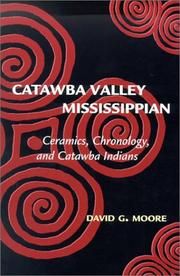| Listing 1 - 3 of 3 |
Sort by
|
Book
ISBN: 9781469638393 1469638398 9781469638379 1469638371 Year: 1983 Publisher: Boone, North Carolina : Appalachian Consortium Press,
Abstract | Keywords | Export | Availability | Bookmark
 Loading...
Loading...Choose an application
- Reference Manager
- EndNote
- RefWorks (Direct export to RefWorks)

ISBN: 0817382097 9780817382094 0817312560 9780817312565 0817311637 9780817311636 0817312560 9780817312565 Year: 2002 Publisher: Tuscaloosa University of Alabama Press
Abstract | Keywords | Export | Availability | Bookmark
 Loading...
Loading...Choose an application
- Reference Manager
- EndNote
- RefWorks (Direct export to RefWorks)
An excellent example of ethnohistory and archaeology working together, this model study reveals the origins of the Catawba Indians of North Carolina. By the 18th century, the modern Catawba Indians were living along the river and throughout the valley that bears their name near the present North Carolina-South Carolina border, but little was known of their history and origins. With this elegant study, David Moore proposes a model that bridges the archaeological record of the protohistoric Catawba Valley with written accounts of the Catawba Indians from the 17th, 18th, and 19th centuries, thus
Mississippian culture. --- Catawba Indians --- Temple Mound culture --- Indians of North America --- Mound-builders --- Kataba Indians --- Siouan Indians --- History. --- Antiquities. --- Antiquities --- Yadkin River Valley (N.C.) --- Catawba River Valley (N.C. and S.C.) --- Yadkin Valley (N.C.) --- Catawba Valley (N.C. and S.C.)
Book
ISBN: 1683400291 1683400178 9781683400172 9781683400059 1683400054 Year: 2017 Publisher: Gainesville
Abstract | Keywords | Export | Availability | Bookmark
 Loading...
Loading...Choose an application
- Reference Manager
- EndNote
- RefWorks (Direct export to RefWorks)
This study reveals how Catawba settlement aggregation, refugee incorporation, and political coalescence affected the scale of interaction networks and communities in the lower Catawba River valley. It also defines the crucial strategies employed in response to food security crises, daily life, and the roles of both men and women. This study highlights the double-edged nature of strategies available to American Indian groups seeking to maintain political autonomy in early colonial period contexts.
Catawba Indians --- Indians of North America --- Kataba Indians --- Siouan Indians --- American aborigines --- American Indians --- First Nations (North America) --- Indians of the United States --- Indigenous peoples --- Native Americans --- North American Indians --- History. --- Culture --- Ethnology --- Catawba River Valley (N.C. and S.C.) --- Catawba Valley (N.C. and S.C.) --- Antiquities.
| Listing 1 - 3 of 3 |
Sort by
|

 Search
Search Feedback
Feedback About UniCat
About UniCat  Help
Help News
News